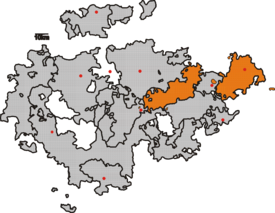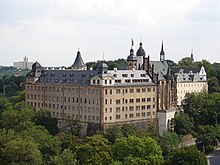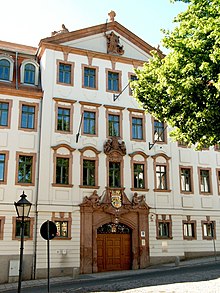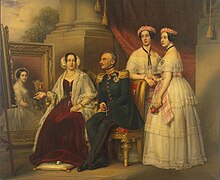Duchy of Saxony-Altenburg
|
||||||||||||||||||||||||||||||||||||||||
Sachsen-Altenburg was a duchy and federal state of the German Empire . Located in what is now the state of Thuringia , it was created in 1603 when part of Saxony-Weimar was separated and left to the sons of Friedrich Wilhelm I (Saxony-Weimar) .
territory
The Duchy of Saxony-Altenburg consisted of two spatially separated areas, the eastern district with the cities of Altenburg , Schmölln , Gößnitz , Lucka and Meuselwitz with the exclaves Mumsdorf , Roschütz , Hilbersdorf , Neukirchen bei Waldenburg and Rußdorf bei Chemnitz and the western district with the towns of Eisenberg , Kahla , Orlamünde and Roda and the exclave Ammelstädt . The eastern district of the duchy corresponded roughly to today's district of Altenburger Land in the Free State of Thuringia, and the area around Ronneburg also belongs to the district of Greiz . Today, the western district is mostly in the Saale-Holzland district , with smaller parts in neighboring districts.
history
In the Middle Ages, the area of the later duchy belonged to the margraviate of Meißen and, since the partition of Leipzig in 1485, it belonged to the Ernestines . After the Wittenberg surrender in 1547, the area around Altenburg became part of the Albertine Electorate of Saxony , but was ceded to the Ernestine Duchy of Saxony as early as 1554 by the Naumburg Treaty . Altenburg came to the Duchy of Saxony-Weimar when Erfurt was partitioned in 1572 .
Duchy of Saxony-Altenburg 1603–1672
After the death of Duke Friedrich Wilhelm I of Saxe-Weimar , his younger brother Johann III took over . the reign of the duchy. But since the sons of the late Friedrich Wilhelm I of Johann III. demanded their inheritance, in 1603 the Duchy of Saxony-Altenburg was separated for them. This area included a. the cities of Altenburg, Camburg , Dornburg , Eisenberg , Roda , Ronneburg and Saalfeld .
The duchy gained territory after the extinction of the duchy of Saxe-Coburg-Eisenach in 1638 and the subsequent division between Saxe-Weimar and Saxe-Altenburg. By drawing lots that fell Coburg 1640 with the offices Coburg , Sonnenfeld , Sonnenberg , Neuhaus , Neustadt , Hildburghausen and Römhild to Duke Friedrich Wilhelm II. Of Sachsen-Altenburg. The principalities of Altenburg and Coburg were ruled by the duke in personal union and kept their own state authorities.
After the division of the county of Henneberg in 1660, the Duchy of Saxony-Altenburg was awarded 3.5 / 12 of the area in the Kahla Treaty with the offices of Meiningen , Maßfeld and Themar , the Behrungen winery , the Hof zu Milz and the Henneberg estate .
Duchy of Saxony-Gotha-Altenburg 1672–1826
1672 died with Friedrich Wilhelm III. the older Sachsen-Altenburg line. The duchy was divided between Saxe-Gotha and Saxe-Weimar. The city of Altenburg itself now belonged with three quarters of the dissolved duchy to Saxe-Gotha, which from now on called itself Saxe-Gotha-Altenburg , but it lost the status of a residential city.
Through an inheritance agreement from 1680, the territory of Saxony-Gotha-Altenburg was divided between several duchies. The Altenburg portion of the county of Henneberg, which was dissolved in 1660, was lost to the duchies of Saxony-Meiningen and Saxony-Römhild . The Principality of Coburg went to the Duchies of Saxony-Coburg and Saxony-Hildburghausen , and Saalfeld became the residence of the Duchy of Saxony-Saalfeld . The Duchy of Saxony-Eisenberg , which was also created during the division in 1680, existed until 1707 and then fell back to Saxony-Gotha-Altenburg.
Duchy of Saxony-Altenburg 1826–1918
After the Saxon-Gotha-Altenburg line had died out, the Ernestine duchies were fundamentally reorganized in terms of territoriality in 1826 . Saxe-Gotha-Altenburg was divided, Altenburg fell to the Duke of Saxe-Hildburghausen, while Gotha fell to the Duke of Saxe-Coburg-Saalfeld , who, however, had to do without Saalfeld, so that the new Duchy of Saxe-Coburg and Gotha came into being. The Duchy of Saxony-Hildburghausen and the Saalfeld part of Saxony-Coburg-Saalfeld fell to the Duchy of Saxony-Meiningen. Duke Friedrich III. In return, von Sachsen-Hildburghausen received Sachsen-Altenburg as an independent duchy with the former part of Sachsen-Eisenberg.
After the Duchy of Saxony-Altenburg received a constitution on April 29, 1831, it joined the German Customs Union as a sovereign federal state in 1833/34 , the North German Confederation in 1867 and finally the German Empire in 1871.
As the last regent of the Duchy of Saxony-Altenburg, Duke Ernst II abdicated on November 13, 1918 and the Free State of Saxony-Altenburg was founded. The last ducal minister of state was Waldemar von Wussow (1915–1918). In 1920, Sachsen-Altenburg was part of the newly formed state of Thuringia (1920–1952) .
State organization and administrative structure
The duchy had a vote in the Bundesrat (German Empire) and Altenburg was the state capital .
In 1876 the two administrative districts Altenburg and Schmölln were established in the eastern district and the administrative district Roda in the western district . The administrative district of Schmölln was dissolved again in 1881 and its area was incorporated into the administrative district of Altenburg. On April 1, 1900, the Roda administrative district in the western district was transferred to the Roda district office . At the same time, the eastern district was divided into the independent city of Altenburg and the new district offices of Altenburg and Ronneburg . In 1910 the duchy comprised a total of 438 parishes, of which only Altenburg could be described as a middle town.
Currency and mail shelf
The duchy joined the Dresden Mint Treaty in 1838 . Two dollars in the Prussian 14-taler monetary standard now corresponded to 3 1 / 2 South German Gulden in 24 1 / 2 -Gulden-feet, which should be considered as common club coin of the "contra end here states". This club coin of "2 Taler = 3 1 ⁄ 2 Gulden" was legally valid in every Zollverein country - regardless of who the respective issuer of the club coin was. Saxony-Altenburg minted its own coins in the royal Saxon coinage (1 thaler at 3O new pennies at 300 pfennigs). Mints existed in Dresden from 1841 to 1869, in Berlin from 1887 to 1903. The very fact that in the Kingdom of Saxony and in the Duchy of Saxony-Altenburg ten pfennigs came to groschen, in Prussia and the Thuringian states influenced by Berlin, but twelve pfennigs to groschen, led to difficulties in the border area. The Prussian pfennig was considered a "bad pfennig" because it was less valuable. It was only with the introduction of the mark as imperial currency on January 1, 1876 under the law of December 4, 1871, that the fragmentation of the monetary system was lifted.
The Thurn-und-Taxis-Post secured the post office shelf through contracts with the Ernestine duchies:
- May 2, 1807 with Duchess Louise Eleonore , regent for her son Bernhard II. Erich Freund, concluded the contract the mail shelf for the Duchy of Saxony-Meiningen,
- April 4, 1807 with Duke Friedrich for the Duchy of Saxony-Hildburghausen,
- June 30, 1816 with Duke Ernst I for the Duchy of Saxony-Coburg-Saalfeld,
- February 24, 1817 with Duke Friedrich IV for the Gotha part of the Duchy of Saxony-Gotha-Altenburg,
- October 26, 1817 with Duke Friedrich IV for the Altenburg part of the Duchy of Saxe-Gotha-Altenburg.
After Duke Friedrich IV of Gotha and Altenburg died on February 11, 1825, without leaving heirs, the Duchy of Gotha fell to Duke Ernst I of Coburg-Saalfeld in the inheritance distribution plan of November 12, 1826, who transferred Saalfeld to Saxony- Meiningen had to resign. Saxony-Altenburg was also created through the inheritance agreement of November 12, 1826 , when it fell to Duke Friedrich , who ceded Hildburghausen to Meiningen in return. Because of the associated new territorial division, some of the contracts had to be renewed. On November 4, 1829 , Duke Bernhard II of Saxony-Meiningen concluded a new feudal mail contract with Prince Maximilian Karl von Thurn und Taxis .
The common administration could already be recognized from the outside by the name, the postal coat of arms and the uniforms, which differed by different collar colors. The name of the post office was: "Herzoglich Altenburgische, Fürstlich Thurn und Taxis'sche Lehenspostexpedition". The postal coat of arms therefore combined both coats of arms, the ducal below and the princely Thurn and Taxissche above. The contract with Thurn und Taxis was canceled in 1847; the royal Saxon post now also supplied Sachsen-Altenburg. On August 1, 1847, the Duchy of Saxony-Altenburg handed over its nine post offices to the Royal Saxon Post after the opening of the railway line Leipzig - Altenburg (September 12, 1842) and Altenburg - Crimmitschau (March 15, 1844), as it is now cheaper with transport was connected to the Kingdom of Saxony.
Judiciary
The higher regional court in Jena, which is common to all Thuringian states, had jurisdiction . It comprised the four Saxon-Ernestine states, the Principality of Schwarzburg-Rudolstadt and the two Russian principalities as well as the Prussian districts of Schmalkalden, Schleusingen and Ziegenrück. The Duchy of Saxony-Altenburg formed the district of the Altenburg Regional Court with six (from 1906 seven) local courts .
- District Court Altenburg (for Saxony-Altenburg) with the six district courts Altenburg , Meuselwitz (from 1906), Ronneburg , Schmölln (for the eastern district); Eisenberg , Kahla , Roda (for the western district).
military
As a member of the German Confederation , the Duchy provided a contingent of 982 infantry and formed the 1st Battalion of the Armed Forces Reserve Division . The infantry formed a battalion and a hunter company in five companies. In 1850 a second battalion was established, so that there was now a fusilier regiment with two battalions of four companies.
After the military convention in the German Empire concluded with Prussia on February 4, 1867, the Altenburg military, together with the contingents of Schwarzburg-Rudolstadt and the two Reuss, formed the 7th Thuringian Infantry Regiment No. 96, which belonged to the 4th Prussian Army Corps in Magdeburg. Its 1st Battalion was garrisoned in Altenburg . After 1897 the 8th Thuringian Infantry Regiment No. 153 was set up, with Altenburg being garrison of the 1st and 2nd battalions. The III. The regiment's battalion was in Merseburg .
coat of arms
Blazon : The coat of arms is divided six times and split twice with a central shield on the fifth and eighth field. In the fields:
- Heart shield (field 5): Divided nine times by black and gold. (Main coat of arms of the Wettins , Ernestine line and small state coat of arms of Saxony-Altenburg)
- Field 1: In blue a lion with a gold crown, divided seven times by silver and red. ( Landgraviate of Thuringia )
- Field 2: In red a golden lily reel with eight lilies, covered with a white heart sign. ( Duchy of Kleve , inheritance claim)
- Field 3: In gold, a black lion. ( Duchy of Jülich , inheritance claim)
- Field 4: In gold, a black lion. ( Margraviate of Meissen )
- Field 5: Two blue posts in gold. ( Margraviate Landsberg )
- Field 6: In silver, a gold-crowned red lion with a double tail. ( Duchy of Berg , inheritance claim)
- Field 7: In blue a gold crowned golden eagle. ( Pfalzgrafschaft Saxony )
- Field 8: Two blue posts in gold. ( Margraviate Landsberg )
- Field 9: In black a golden eagle (Pfalzgrafschaft Thuringia)
- Field 10: In the field sprinkled with ten red hearts, a black lion with a red crown. ( County of Orlamünde )
- Field 11: In silver a red rose with a golden clasp and green sepals. ( Burggrafschaft Altenburg in Thuringia)
- Field 12: Split of silver and blue, occupied by a gold crowned lion in mistaken tincture. ( Principality of Lichtenberg in the Palatinate)
- Field 13: Three blue bars in silver. (Lordship of Eisenberg in the Stadtroda district).
- Field 14: In red, a soaring silver horse. ( Duchy of Westphalia , inheritance claim)
- Field 15: Three red sea leaves in silver (2: 1). (County of Brehna in the Bitterfeld district)
- Field 16: In gold, a bar cut 21 times in three rows of silver and red. ( County of Mark in Westphalia, inheritance claim)
- Field 17: A silver slanted left bar in red, separated from a black raven turned left at the top right. ( Lordship of Ravenstein in Noord-Brabant , inheritance claim)
- Field 18: Three red rafters in silver. ( County of Ravensberg in Westphalia, inheritance claim)
- Field 19: In gold on a green three-hill a black rooster with a red crest. (Princely county of Henneberg )
- Field 20: In red a silver column with a gold crown on it. (Römhild in the Hildburghausen district)
- Field 21: Red. ( Regalienfeld )
Residents
The duchy counted
- 1871: 142,122 inhabitants
- 1875: 145,844 inhabitants
- 1880: 155,036 inhabitants
- 1900: 194,914 inhabitants
- 1905: 206,508 inhabitants
- 1910: 216,128 inhabitants
Biggest cities
|
|
In addition, in 1910, compared to 1837, the following places were above the 2,000 mark: City of Meuselwitz (8,865 - 1,527; + 481%), City of Gößnitz (5,813 - 1,528; + 280%), municipality of Rußdorf (3,579 - 1,031; + 247%) ), Municipality of Hermsdorf (3,417 - 1,046; + 227%), municipality of Bad Klosterlausnitz (2,204 - 1,090; + 102%), city of Lucka (2,086 - 1,245; + 68%) and municipality of Kauerndorf (2,024 - 102; + 1,884%) .
economy
In Altenburg, the duchy owned a world-famous playing card factory , as did a porcelain industry in Kahla. Machine and metal goods were also produced to a small extent, the world-famous sewing machine manufacturer Vesta should be mentioned here . The agriculture mainly operated the cultivation of wheat, rye, barley, oats, potatoes, fruit and vegetables, favored by the high-yield loess soils of East Thuringia. For the year 1907, the duchy's livestock is given as 12,401 horses, 67,745 cattle, 7,568 sheep, 77,681 pigs and 15,594 goats. In the same year, mining in the Meuselwitz-Rositzer district produced 3,060,777 tons of lignite. A mineral bath with a spa in Ronneburg promoted tourism. The lively trade in the duchy was supported by the operation of 185 km of railway lines, a state and savings bank, and 19 savings banks.
Expression of rural prosperity, Altenburger Vierseithöfe
religion
Most of the residents belonged to the Evangelical Church , whose head was the Duke of Saxony-Altenburg as summus episcopus . In 1907 this was divided into eight administrative districts with 103 parishes. The Catholics were subordinate to the Apostolic Vicariate of Saxony, based in Dresden.
Dukes
Saxony-Altenburg 1603–1672
- 1603–1618 custodian of Elector Christian II of Saxony and Johann Georg I of Saxony in place of Johann Philipp , Friedrich (1599–1625) , Johann Wilhelm (1600–1632) and Friedrich Wilhelm II. , Sons of Friedrich Wilhelm I.
- 1618–1639 Johann Philipp (1597–1639)
- 1639–1669 Friedrich Wilhelm II. (1603–1669)
- 1669–1672 guardian Elector Johann Georg II of Saxony and Duke Moritz of Saxony-Zeitz in place of Friedrich Wilhelm III. (1657–1672), son of Friedrich Wilhelm II.
Saxe-Gotha-Altenburg 1672–1826
Saxony-Altenburg 1826–1918
- 1826–1834 Friedrich (1763–1834)
- 1834–1848 Joseph (1789–1868)
- 1848-1853 Georg (1796-1853) - brother of Joseph
- 1853–1908 Ernst I (1826–1908)
- 1908–1918 Ernst II. (1871–1955) - nephew of Ernst I.
With the death of the former Hereditary Prince Georg Moritz von Sachsen-Altenburg (1900–1991), the eldest son of Ernst II, the Sachsen-Altenburg line of the Wettins became extinct in 1991 in the male line .
Residential castles
From 1826 the ducal family resided in the residential palace in Altenburg. The Eisenberg residential palace was only the residence of Duke Christian von Sachsen-Eisenberg from 1681 to 1707 . The Hunting Lodge for the Merry Return in Wolfersdorf was built in the Renaissance style from 1548 to 1551 (neo-Gothic alterations in 1858) and was named after the return of Elector Johann Friedrich I from captivity. After his abdication in 1918, the last Duke Ernst II lived here until his death in 1955. Another ducal hunting lodge was located in Hummelshain , which was supplemented by a new building in the neo-Renaissance style, the New Hummelshain Hunting Lodge , from 1880–85 .
Old hunting lodge in Hummelshain
literature
- Johann B. Homann: The duchies of Gotha, Coburg and Altenburg 1729. Historical map: Tabula Geographica Principatus Gotha, Coburg, Altenburg. Verlag Rockstuhl, Bad Langensalza, Reprint 1757/1999, ISBN 3-929000-78-4 .
- Matthaeo (Matthias) Seutter: The offices of Altenburg and Ronneburg 1757. Historical map: Praetecturae Altenburgensis et Ronneburgensis earumque vicinia serenissimo duci saxo gothano. Verlag Rockstuhl, Bad Langensalza, Reprint 1757/1999, ISBN 3-932554-57-4 .
- Julius Löbe , Ernst Conon Löbe : History of the churches and schools of the Duchy of Saxony-Altenburg with special consideration of the local history. 3 volumes. Bonde, Altenburg 1886–91 ( digitized volume 1 ; digitized volume 2 ; digitized volume 3 ).
Web links
- Duchy of Saxony-Altenburg . In: Meyers Konversations-Lexikon . 4th edition. Volume 14, Verlag des Bibliographisches Institut, Leipzig / Vienna 1885–1892, p. 143.
- Duchy of Saxony-Altenburg 1826–1918
- Duchy of Saxony-Altenburg (districts and communities) 1910
Individual evidence
- ^ Thuringian State Archives Altenburg (ed.): Rautenkranz and red rose: The emblems of the duchy and the Free State of Saxony Altenburg. Sax-Verlag, Altenburg, 2010.
- ^ Georg Wilhelm Sante (ed.): History of the German Lands - "Territories Ploetz". Vol. 1: The territories until the end of the old empire. A.-G.-Ploetz-Verlag, Würzburg 1964, p. 468.
- ^ "Edict of November 4, 1829, concerning the postal loan relationships and the postal administration"
- ^ Heinrich Ambros Eckert and Dietrich Monten, Das deutsche Bundesheer, Volume II., Dortmund 1981, p. 14.


















